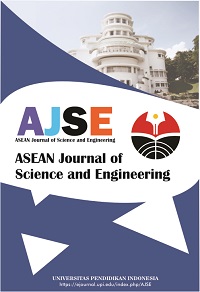Potential Production of Bioplastic from Water Hyacinth (Eichornia crassipes)
Abstract
The purpose of this research was to determine the potential and capability of water hyacinth (Eichornia crassipes) as bioplastics. The produced bioplastic was naturally biodegradable and can be used for natural conservation without environmental destruction. The study was experimental using various compositions of water hyacinth, characterized by tensile strength and biodegradability tests to determine the potentiality and capability of water hyacinth as a source of bioplastic. In making the bioplastic, we extracted the water hyacinth and utilized glycerine as a plasticizer, water as the solvent, corn-starch as a thickener, and vinegar. After mixing all materials on a pan, the mixed solution was placed on a stainless surface and dried. After a 3-day curing period, the results showed that different mechanical and decomposition properties were obtained. Based on the results of the study, water hyacinth is one of the suitable materials that can be used to produce a new and sustainable bioplastic material. It is organic and accessible, thus making it a candidate for innovation in the creation of bioplastic. Therefore, we believe that the use of water hyacinth is a potential bioplastic material that is beneficial to the environment and the community.
Keywords
Full Text:
PDFReferences
Gautam, R., Bassi, A. S., and Yanful, E. K. (2007). A review of biodegradation of synthetic plastic and foams. Applied Biochemistry and Biotechnology, 141(1), 85-108.
Limboonruang, T., and Phun-Apai, N. (2018). Study on property of biodegradable packaging from water hyacinth fibers. Journal of Engineering Science and Technology, 13(11), 3648-3658.
Malachová, K., Novotný, Č., Adamus, G., Lotti, N., Rybková, Z., Soccio, M., and Fava, F. (2020). Ability of trichoderma hamatum isolated from plastics-polluted environments to attack petroleum-based, synthetic polymer films. Processes, 8(4), 467.
Shah, A. A., Hasan, F., Hameed, A., and Ahmed, S. (2008). Biological degradation of plastics: A comprehensive review. Biotechnology Advances, 26(3), 246-265.
Villamagna, A. M., and Murphy, B. R. (2010). Ecological and socio‐economic impacts of invasive water hyacinth (Eichhornia crassipes): A review. Freshwater Biology, 55(2), 282-298.
Webb, H. K., Arnott, J., Crawford, R. J., and Ivanova, E. P. (2013). Plastic degradation and its environmental implications with special reference to poly (ethylene terephthalate). Polymers, 5(1), 1-18.
Wilkes, R. A., and Aristilde, L. (2017). Degradation and metabolism of synthetic plastics and associated products by Pseudomonas sp.: Capabilities and challenges. Journal of Applied Microbiology, 123(3), 582-593.
DOI: https://doi.org/10.17509/ajse.v2i2.37801
Refbacks
- There are currently no refbacks.
Copyright (c) 1970 Universitas Pendidikan Indonesia

This work is licensed under a Creative Commons Attribution-ShareAlike 4.0 International License.












